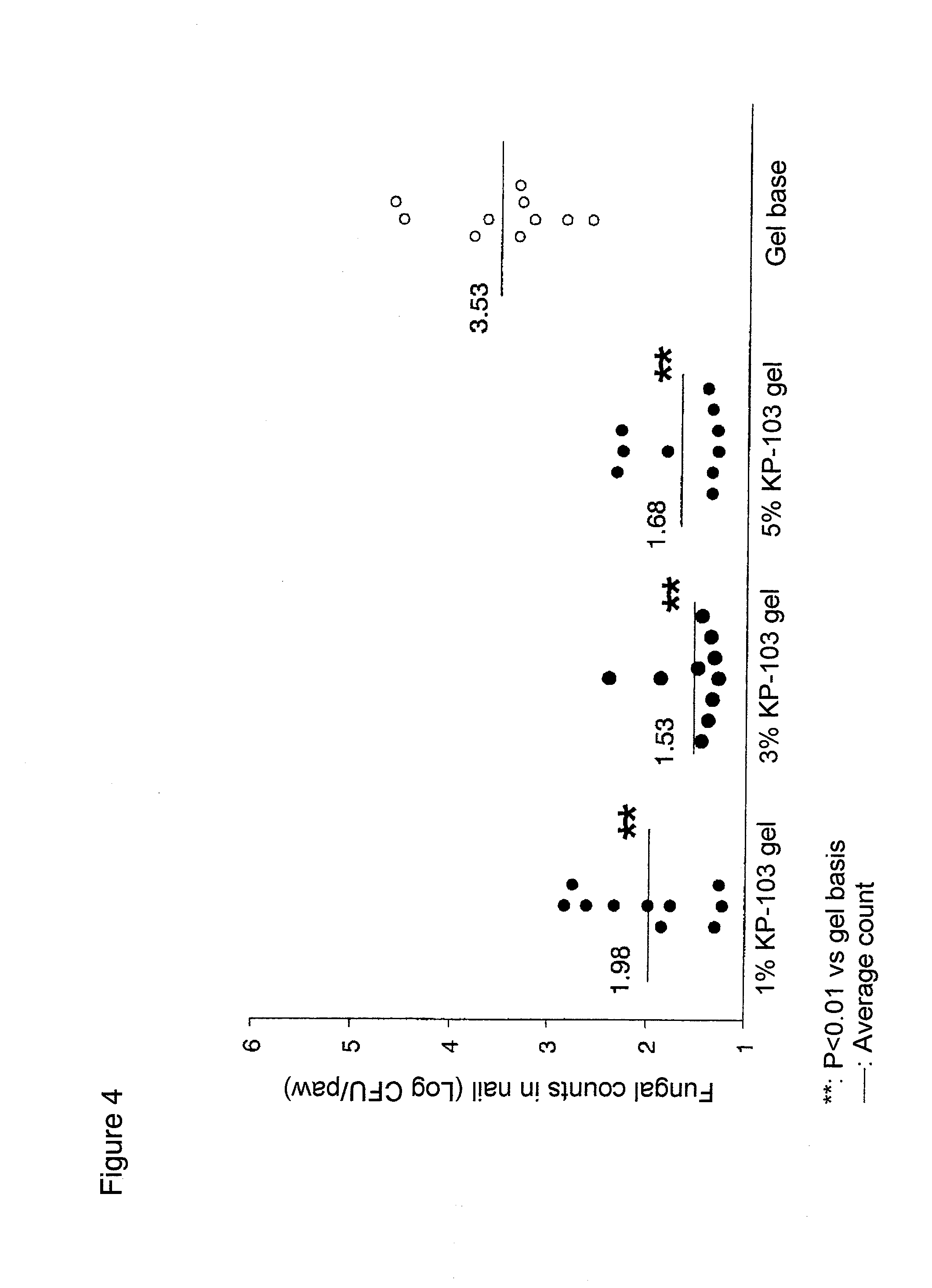Gel composition for treating mycosis
a gel composition and mycosis technology, applied in the field of gel composition for mycosis treatment, can solve the problems of not producing any antifungal effect on fungi in the nail, reducing patient compliance, and requiring 3 to 6 months of nail turnover for oral treatment, so as to reduce and reducing the effect of fungal counts
- Summary
- Abstract
- Description
- Claims
- Application Information
AI Technical Summary
Benefits of technology
Problems solved by technology
Method used
Image
Examples
examples 1 to 5
[0062]In Examples 1 to 5 shown below, individual ingredients were mixed to prepare a gel composition according to the following formula. First, among the ingredients, KP-103 was dissolved in ethanol. To this solution, triacetin, glycerine (and 1,3-butylene glycol) were added and mixed, followed by addition of carboxyvinyl polymer. The mixture was warmed to disperse the carboxyvinyl polymer. After cooling, diisopropanolamine was added to prepare a gel composition. The carboxyvinyl polymer used was Hiviswako® 104, which is a product of Wako Pure Chemical Industries, Ltd., Japan. To measure the pH of each gel composition, 0.1 g of the gel composition was diluted in 5 mL water and measured with a pH meter (F-23, Horiba, Ltd., Japan).
[0063]Based on the mass of the whole composition to be prepared, which was set to 100 g, individual ingredients were mixed at the ratio indicated below to prepare the composition (gel preparation) of Example 1 according to the present invention.
TABLE 1KP-103...
examples 6 to 11
[0074]Compositions (gel preparations) were prepared based on the formula used in Example 4 by varying the amount of KP-103 and the type of carboxyvinyl polymer as indicated in the table below. Carbopol® 940 is a product of Noveon, Inc. and Synthalen® K is a product of 3V SIGMA.
TABLE 6Example 6Example 7Example 8Example 9Example 10Example 11KP-103 1 g 3 g 3 g 5 g 5 g 5 gCarboxyvinyl 1 g 1 g 1 g 1 g 1 g 1 gpolymer(Carbopol(Hiviswako(Carbopol(Hiviswako(Carbopol(Synthalen(trade name)940)104)940)104)940)K)Triacetin15 g15 g15 g15 g15 g15 gAnhydrous ethanolq.s.q.s.q.s.q.s.q.s.q.s.Concentrated35 g35 g35 g35 g35 g35 gglycerin1,3-Butylene glycol25 g25 g25 g25 g25 g25 gDiisopropanolamine0.2 g 0.2 g 0.2 g 0.2 g 0.2 g 0.2 g Tocopherol0.01 g 0.03 g 0.03 g 0.05 g 0.05 g 0.05 g
examples 12 to 15
[0075]Compositions (gel preparations) were prepared based on the formula used in Example 4 by varying the amounts of polyhydric alcohols, except for concentrated glycerin, as indicated in the table below.
TABLE 7Example 12Example 13Example 14Example 15KP-103 1 g 1 g 1 g 1 gCarboxyvinyl polymer 1 g 1 g 1 g 1 g(trade name)(Hiviswako 104)(Hiviswako 104)(Hiviswako 104)(Hiviswako 104)Triacetin15 g15 g15 g15 gAnhydrous ethanolq.s.q.s.q.s.q.s.Concentrated glycerin35 g35 g35 g35 g1,3-Butylene glycol 5 g—15 g—Dipropylene glycol20 g20 g—15 gTriethylene glycol— 5 g10 g10 gTocopherol0.2 g 0.2 g 0.2 g 0.2 g
PUM
| Property | Measurement | Unit |
|---|---|---|
| mass | aaaaa | aaaaa |
| contact area | aaaaa | aaaaa |
| temperature | aaaaa | aaaaa |
Abstract
Description
Claims
Application Information
 Login to View More
Login to View More - R&D
- Intellectual Property
- Life Sciences
- Materials
- Tech Scout
- Unparalleled Data Quality
- Higher Quality Content
- 60% Fewer Hallucinations
Browse by: Latest US Patents, China's latest patents, Technical Efficacy Thesaurus, Application Domain, Technology Topic, Popular Technical Reports.
© 2025 PatSnap. All rights reserved.Legal|Privacy policy|Modern Slavery Act Transparency Statement|Sitemap|About US| Contact US: help@patsnap.com



